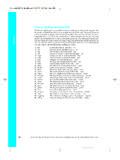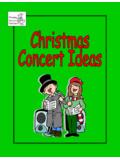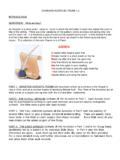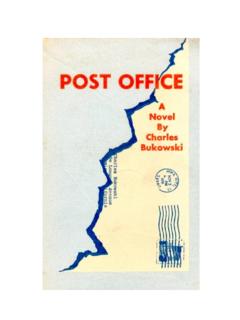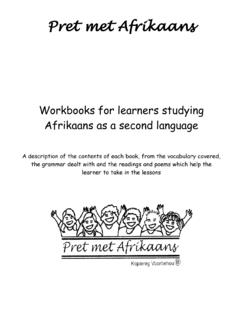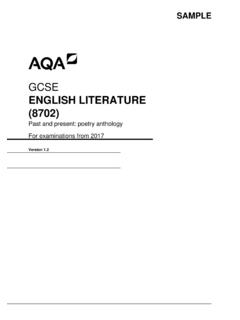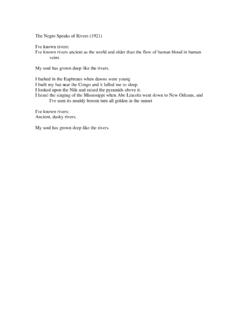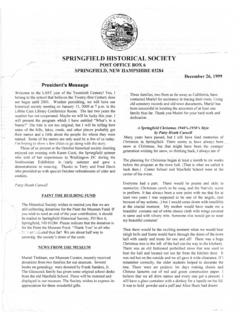Transcription of Suggested Read Aloud Titles – Grades K-8
1 Teachers College Reading and Writing Project Suggested read Aloud Titles Grades K-8 The levels of these books were proposed by teachers, literacy coaches and staff developers, and a few of those levels may, in fact, be wrong. Send us your observations and we ll refine the levels. The summaries come from , , , and April, 2009 TCRWP--DRAFT Page 1 of 13 Interactive read Aloud With Accountable Talk The interactive read Aloud with accountable talk is a powerful teaching component in balanced literacy classrooms. Research confirms the importance and value of reading Aloud to students of all ages.
2 Teachers read Aloud several times a day, and at least three times a week create opportunities for accountable talk around the read Aloud . This component is generally outside the reading workshop (which centers around a minilesson and independent reading) but the read Aloud often supports the reading workshop. It s important that teachers plan for the interactive read Aloud . The choice of text is the first important decision. Teachers need to consider how the text can support or lead the reading work students do independently. For example, if the class is engaged in the unit of study on character (and students are thinking about the characters as they read independently) the teacher might be wise to read Aloud a chapter book which contains strong characters who change over the course of the text.
3 This would offer the class opportunities for deep talk about characters. If the class is working on nonfiction, and some or most of children s independent reading involves non-fiction texts, the teacher would definitely want to read Aloud some nonfiction texts to support the children s independent work. In addition to planning what book to read Aloud , teachers need to plan the work they ll do within the book. We suggest that as teachers, you put post-its in the text ahead of time to remind yourself where you plan to pause and think Aloud and where you want to nudge your students to turn and talk about the text.
4 Let me explain. When we say that you may want to plan places in the text where you will think Aloud , we are imagining that these think alouds are opportunities for you to model that strong readers don t just read the words but also think about the story. For example, if you stop in the middle of a chapter and say, I can t believe the character is acting this way. I wonder why she s being like you demonstrate to your students that readers question the characters and wonder about their motivations. If you think Aloud by saying, I bet she s going to lose the bracelet, you model that readers make predictions as they read .
5 When you say to your class, I want just to reread that part again. I was daydreaming and lost the story, you teach that rereading is a strategy, readers reread to regain comprehension. Besides thinking Aloud , you will provide opportunities throughout the book for children to turn and talk to each other about the text. Prompt the class by saying something like, Turn and tell your neighbor what you think will happen next, or Let s think about what s going on here. Turn and talk to your neighbor about what you think (so and so) is thinking right now. To prepare for the interactive read Aloud , reread the text in a really thoughtful way.
6 Spy on yourself as you read in order to notice a few places in each chapter where your brain does a lot of reading-work. Note those sections. Later, review each one. Ask, Was I doing a lot of thinking here because the text is written in such a way that lots of readers will be thinking at this section? (or was your response totally idiosyncratic?) If the section of the text seems to ask for a thoughtful response, you may decide use this as an opportunity to teach: You may think Aloud . This means you ll pause at this section of the text and be pensive Aloud . something weird is going on.
7 It s giving me the creeps! you might say. Or Why s he so mad? I m going to read to find out. Don t say a a line or two is usually enough. Teachers College Reading and Writing Project Suggested read Aloud Titles Grades K-8 The levels of these books were proposed by teachers, literacy coaches and staff developers, and a few of those levels may, in fact, be wrong. Send us your observations and we ll refine the levels. The summaries come from , , , and April, 2009 TCRWP--DRAFT Page 2 of 13 By doing this you will demonstrate that readers predict, envision, question, develop theories about characters, monitor for but you won t be talking to kids about these reading skills.
8 You ll simply read in a way that demonstrates the thinking readers do. Alternately, you may recruit kids to join you (and then to continue without you) in the thinking that good readers do at this section. You ll usually start them off by naming your thinking, but then you ll set them up to continue that line of thought with two minutes of talk with a neighbor. Hmm, I have a feeling he s not going to stay silent for wonder what he ll say, don t you? Tell your neighbor what you think he ll say. When you pause after a few pages of reading to let kids talk with a neighbor, don t engineer things so the whole class reports back after these one to one talks.
9 Don t ask kids to report on what they said. Just read on. At the end of the chapter, you may have a bigger book talk. For reading Aloud , select a book or text that you love and believe your children will love too. Be sure you read it first. You might try starting with some of the briefer ones. But most of all, select texts you know and love. Level Title/Author/ISBN #/Book Type Summary Amber Was Brave, Essie Was Smart Vera B. Williams 9780060571825 Chapter Book A funny book that makes you cry. A sad book that makes you laugh. A book about two sisters and their family that makes you wish you were part of it--and grateful that you are not.
10 In short, this book is one surprise after another. Open the book. You will never be the same again. Best Christmas Pageant Ever, The Barbara Robinson 9780380007691 Chapter Book Called one of America's favorite Christmas stories, and now a classic television movie, The Best Christmas Pageant Ever has been a favorite of young readers the world over since 1972. It is the story of a family of incorrigible children who discover the Christmas story for the first time and help everyone else rediscover its true meaning. Birdsongs Betsy Franco 9780689877773 NF Picture Book This text introduces readers to many different kinds of birds, each of which makes its own unique sound.
